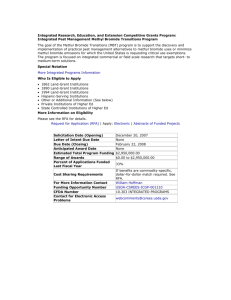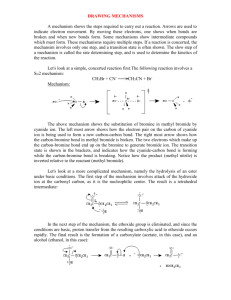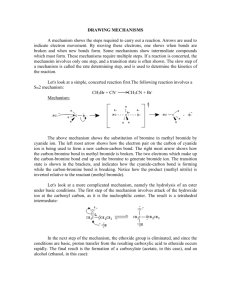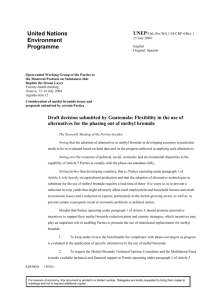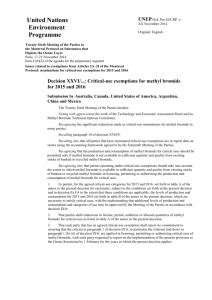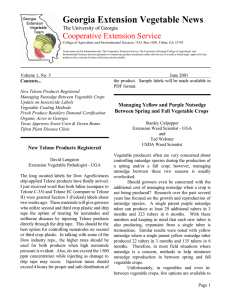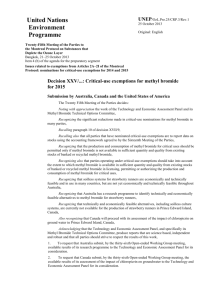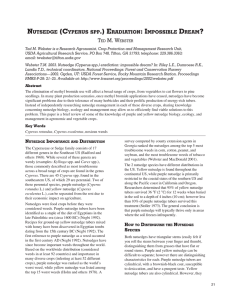Georgia Extension VegetableNews Cooperative Extension Service The University of Georgia
advertisement
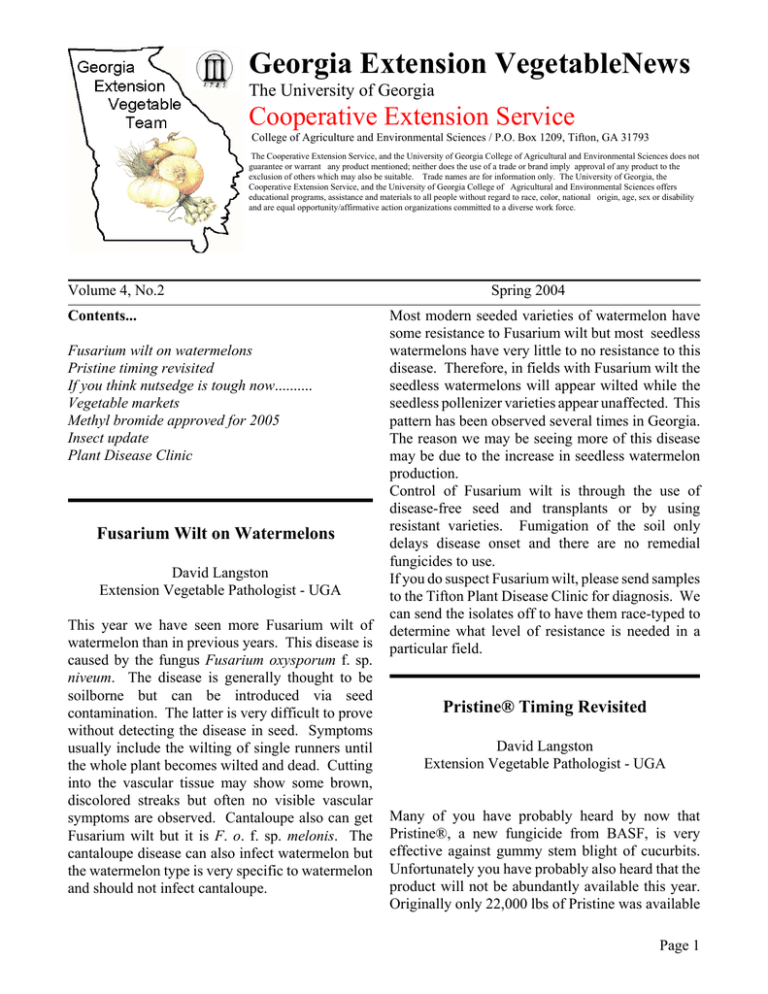
Georgia Extension VegetableNews The University of Georgia Cooperative Extension Service College of Agriculture and Environmental Sciences / P.O. Box 1209, Tifton, GA 31793 The Cooperative Extension Service, and the University of Georgia College of Agricultural and Environmental Sciences does not guarantee or warrant any product mentioned; neither does the use of a trade or brand imply approval of any product to the exclusion of others which may also be suitable. Trade names are for information only. The University of Georgia, the Cooperative Extension Service, and the University of Georgia College of Agricultural and Environmental Sciences offers educational programs, assistance and materials to all people without regard to race, color, national origin, age, sex or disability and are equal opportunity/affirmative action organizations committed to a diverse work force. Volume 4, No.2 Contents... Fusarium wilt on watermelons Pristine timing revisited If you think nutsedge is tough now.......... Vegetable markets Methyl bromide approved for 2005 Insect update Plant Disease Clinic Fusarium Wilt on Watermelons David Langston Extension Vegetable Pathologist - UGA This year we have seen more Fusarium wilt of watermelon than in previous years. This disease is caused by the fungus Fusarium oxysporum f. sp. niveum. The disease is generally thought to be soilborne but can be introduced via seed contamination. The latter is very difficult to prove without detecting the disease in seed. Symptoms usually include the wilting of single runners until the whole plant becomes wilted and dead. Cutting into the vascular tissue may show some brown, discolored streaks but often no visible vascular symptoms are observed. Cantaloupe also can get Fusarium wilt but it is F. o. f. sp. melonis. The cantaloupe disease can also infect watermelon but the watermelon type is very specific to watermelon and should not infect cantaloupe. Spring 2004 Most modern seeded varieties of watermelon have some resistance to Fusarium wilt but most seedless watermelons have very little to no resistance to this disease. Therefore, in fields with Fusarium wilt the seedless watermelons will appear wilted while the seedless pollenizer varieties appear unaffected. This pattern has been observed several times in Georgia. The reason we may be seeing more of this disease may be due to the increase in seedless watermelon production. Control of Fusarium wilt is through the use of disease-free seed and transplants or by using resistant varieties. Fumigation of the soil only delays disease onset and there are no remedial fungicides to use. If you do suspect Fusarium wilt, please send samples to the Tifton Plant Disease Clinic for diagnosis. We can send the isolates off to have them race-typed to determine what level of resistance is needed in a particular field. Pristine® Timing Revisited David Langston Extension Vegetable Pathologist - UGA Many of you have probably heard by now that Pristine®, a new fungicide from BASF, is very effective against gummy stem blight of cucurbits. Unfortunately you have probably also heard that the product will not be abundantly available this year. Originally only 22,000 lbs of Pristine was available Page 1 for the southeastern U.S. this summer. However, more has been made available since the last newsletter but supplies still do not cover the demand. Therefore, if you have growers that do manage to acquire some Pristine, they should use it at the most effective time possible. I have recommended that Pristine be applied once watermelons are at beginning fruit set or at least 21 days prior to harvest. This allows you to use the material at a critical time when chlorothalonil may burn melons and when most watermelons seem to severely affected by gummy stem blight. This fungicide, like most fungicides, works much better if applied prior to disease onset. Do not apply Pristine once disease has become established as this places much more pressure on the fungicide for resistance development. As with most selective chemistries, please rotate Pristine with fungicides of a different mode of action. I recommend the 12.5 oz rate for gummy stem blight but you may need to go higher if control of downy mildew is needed. Nutsedge, You Think It Is Tough To Manage Now.....Wait Till Methyl Bromide is Finally Gone!!! Stanley Culpepper Extension Weed Scientist - UGA Ted Webster USDA Weed Scientist By now everyone should be aware that the Critical Use Exemption Packages submitted by the Georgia Fruit and Vegetable Growers Association were successful. The availability and use of methyl bromide for many Georgia growers is extended through the 2005 season. Although this battle has been won, we must begin thinking about managing nutsedge species aggressively in preparation for the loss of methyl bromide – as we are going to lose the war on methyl bromide use. Research efforts in Georgia have shown that from a single yellow nutsedge plant there can be over 600 yellow nutsedge tubers (and thus potential plants) produced within 4 months. Yellow nutsedge is the easier of the two troublesome nutsedge species to mange, as it is often more readily controlled by several herbicides and fumigants when compared to purple nutsedge. Not only is purple nutsedge usually harder to manage, but it also has the natural ability to spread itself throughout a field. Without tillage, spread of purple nutsedge was 43-times greater than yellow nutsedge in a study conducted during 2003. With ability of these nutsedge species to proliferate and spread, one can easily see how light infestations of nutsedge can become severe infestations in just a matter of months. One of the critical first steps to managing nutsedge species in the absence of methyl bromide will be the proper identification of each species. Yellow nutsedge plants are often larger and a lighter shade of green than purple nutsedge plants which tend to have a deeper green color and be smaller in height. The tips of yellow nutsedge plants leaves are long and drawn out, coming to a gradual tapered point. In contrast, the tips of purple nutsedge leaves come to an abrupt point. Yellow nutsedge tubers are clustered around the initial “mother” shoot, while purple nutsedge tubers are formed in chains that can extend some distance from the mother shoot. One of the most distinguishing features of yellow and purple nutsedge is the inflorescence (collection of flowers). Yellow nutsedge has a pale yellow inflorescence, while that of purple nutsedge is a reddish-purple color. However, by the time that you see the flowers, tuber production has already begun. Currently, we are searching for methyl bromide alternatives and several of our systems are quite effective. Even with these potential methyl bromide alternatives, control of nutsedges will be a significant challenge after methyl bromide is gone. Thus it is critical that growers aggressively attack their current nutsedge infestations with a “systems approach”, even while methyl bromide is still available. Growers need to utilize tactics including selective herbicides (Sandea and Dual Magnum in labeled crops) when feasible; Roundup WeatherMax in row middles and after final crop harvest; and post-crop harvest control tactics such as tillage or use of fumigants such as metham (various trade names) applied through the drip in beds that will be used next season. Page 2 Growers constantly fuss about the poor control that glyphosate (e.g. Roundup-type products) provides for nutsedge species. One must remember that desiccating the above ground portion of the nutsedge plant (the visible portion of the problem) is not as important as reducing tuber production below ground (the real problem). Glyphosate is a better option that Gramoxone for reducing tuber production and thus field infestations of nutsedge. Sequential glyphosate applications are often very effective in managing nutsedge and should be implemented and applied before and between crops. If glyphosate is applied overtop of plastic make sure to wash off the plastic with a half inch of rain prior to planting the next crop. It is strongly advised that growers need to begin exploring methyl bromide alternative systems including other fumigant/herbicide combinations! Research efforts are currently looking at over 36 fumigant/herbicide systems to replace methyl bromide. Many of these options are promising and adaption by growers at least on a small scale in the fall of 2004 and spring of 2005 would be suggested. When methyl bromide is finally gone, and it certainly appears inevitable, a little experience with some of these alternatives will go a long way in adopting these practices and technologies on a large scale. Source: Vegetables and Outlook/VGS-302/April 21, 2004. Melon During the spring-season fresh market for selected vegetables, onion acreage declined in 2003 and increased in 2004. A similar trend was observed for tomatoes during the same time frame. Bell pepper acreage remained consistent from 2002-2004. Sweet corn acreage continuously decreased from 2002 to 2004. Although snap beans also took a nose dive in 2003, production acreage quickly increased in 2004. Fig. 2: Spring-Season Fresh Market for Selected Vegetables, 2002-2004 Source: Vegetables and Melon What is New About the Vegetable Industry? Esendugue Greg Fonsah Extension Economist - UGA The United States vegetable industry has been experiencing a decline in area harvested. ERS report shows 4.8% drop in harvested area from 2002 to 2003 and a subsequent 2.0 % drop from 2003 to 2004. On the other hand, total production equally dropped to 2.5% from 2002 to 2003 and remained stagnant thereafter. Fig 1: U.S. Vegetable Production and Area Harvested, 2002-2004 Outlook/VGS-302/April 21, 2004. The lesson to learn from this is that, growers should pay particular attention to production and acreage trend for various vegetable before planting. Vegetables showing evidence of excess production may signal trouble in terms of prices. Whereas, vegetables showing declining trend in both area harvested and total production may be worth taking the risk. An earlier price trend study (Fonsah, 2004) illustrated that all vegetables except watermelon, Page 3 experienced increased prices in 2003. That scenario was triggered by the decrease in both area harvested and production. Year 2004 is expected to be yet another good year for growers. The U.S. Environmental Protection Agency will now begin the process of determining how the allotment is distributed among the states. They held several stakeholder meetings last year to get input on the allocation process. However, several scenarios are under consideration and at the current time, it is not certain how this process will work. U.S. Gets Methyl Bromide Ctritical Use Exemption Approved The current exemption is for 2005 only. The UGA Extension Vegetable Team has already helped the Georgia Fruit and Vegetable Growers Association prepare and submit a critical-use exemption for 2006. A decision will be made on that application later this year. Terry Kelley Extension Horticulturist - UGA The United Nations Environment Program has agreed to grant a critical use exemption for methyl bromide for 2005. After much discussion and haggling, the Methyl Bromide Technical Options Committee finally agreed on the one-year exemption at the current level of production for the United States. Eleven other nations also received critical use exemptions. This is especially good news for Georgia vegetable growers who use the multi-purpose fumigant for control of nematodes, soil-borne pathogens and weeds. After failing to reach a concensus at their meeting in November, the MBTOC finally settled on an agreement in Montreal the last week in March. The exemption has been granted for squash, cucumber, cantaloupe, eggplant, pepper, tomatoes and strawberries as well as several other uses. Methyl bromide was slated to be phased out of production Jan. 1, 2005 with developing nations phasing out production by 2015. The phase out program is part of the Montreal Protocol, a treaty signed by the United States and more than 180 other countries to reduce ozone-depleting substances. The United States will be permitted to produce 7,659 tons of methyl bromide in 2005. This amounts to about 30 percent of what was produced in 1991, the last year before the phase-out began. It is an amount equal to what has been produced since the beginning of 2003. All stocks will still be available for use above what was allowed by the critical use exemption. It has been estimated that the critical use exemption may be worth as much as $120 to the Georgia vegetable industry which has a total value of about $650 million. University and government researchers continue to look for effective, economical ways to replace methyl bromide, but currently there is no consistently viable alternative. However, growers will likely have to go to alternative methods in the near future. The price of methyl bromide has tripled in the past decade reducing its economic viability. Additionally, it is unlikely that these critical use exemptions will be granted year after year for very long. Vegetable Insect Update Stormy Sparks Extension Entomologist - UGA Thrips on Everything Thrips have become a problem for many vegetable growers over the past couple of weeks. The worst damage appears to have been on beans simply because of their susceptibility. While thrips are probably on young vegetables this time of year just about every year, the problems have been more pronounced because of higher thrips populations and poor plant growth conditions. Early plantings this year have experienced slow growth because of the weather (mostly cool nights). Many of these crops probably host thrips every year, but under Page 4 good growing conditions they outgrow the damage before it is noticeable. Hopefully that will occur with the recent rains and warmer weather. In a recent trail on beans in Tift County, both an organophosphate (Orthene in this trial) and the pyrethroid (Mustang Max) gave fairly good control. With most crops, fairly good control of thrips is about all you will get. Thrips like tight places and getting insecticide to them can be difficult. Your results on thrips can vary with crop and thrips species. Most of what I have seen recently appears to be tobacco thrips, but I would expect western flower thrips and others to increase soon. While direct damage to foliage is generally not a concern with thrips once the plants are well established, if you are dealing with a spotted wilt susceptible crop, you should have already been controlling thrips. Spider mites Spider mites have already reared their ugly little eight-legged bodies and have shown up on a variety of crops. Spider mites like hot dry weather, and while we have not been hot, we have been dry. The dry weather allows for greater survival of the mites, and while the cool weather has slowed down their development, it has also slowed down plant growth. If the mites come through the current rains and it turns hot and dry again, they could require control. Options for mite control vary considerably from crop to crop. For most crops, the cheapest true miticide is Kelthane or dicofol. If you use Kelthane, make sure your water pH is in the 5 to 7 range BEFORE you add the Kelthane. I put out Kelthane one time in 3 liter bottles with and without buffer. It only took about 10 to 15 minutes to mix and apply the solution, and the results were dramatic. Fifteen minutes in a high pH water pretty much eliminated control. Other true miticides for vegetables include Agrimek and Acramite. Both of these will give longer residual activity than anything else you might use, but are limited in the crops for which they are registered and come with increased costs. When you move away from the strict miticides to alternate insecticides you might use, the list gets a little longer. Many of the organophosphate insecticides have limited activity on mites, but also tend to have very short residual activity. Two pyrethroids are also commonly used for mite control (bifenthrin [Capture, Discipline] and Danitol), but are used strictly at the high end of their rate ranges for mites. Finally, Proclaim has also shown good activity on spider mites. With all these choices, how do you chose what to use for mites. The first step is to decide the purpose of your treatment. If you are controlling mites and only mites, I would probably select one of the true miticides based on cost and need for residual control. Other than that, it depends on the mix of pests present, and the threat of mite build up. The two pyrethroids would provide the broadest spectrum of control, and Procalim would provide good control of both spider mites and caterpillar pests. Tifton Plant Disease Clinic Jason Brock Plant Disease Diagnostician - UGA The vegetable samples diagnosed at the Tifton clinic during April 2004 are listed below. (The number in parentheses indicated multiple samples.) Pythium root rot was the most commonly diagnosed disease, being a problem with multiple crops. The cool nights and irrigation likely created a environment conducive for this disease. Also of note was a positive test for watermelon fruit blotch. This seems to have been an isolated event and is not causing great alarm. Last May was a busy month for the disease clinic. If we receive more rains, this May promises to be busy as well. The most common diagnoses last year included gummy stem blight of cucurbits, bacterial diseases of all crops, and Phytophthora and Pythium diseases. All of the diseases are favored by an abundance of moisture, either from rainfall or irrigation. Page 5 Bean: Pythium root rot (2) probable chemical injury Cabbage: no disease (2) Cantaloupe: Pythium root rot Collard: no disease Cucumber: Gummy stem blight Onion: neg for virus Pepper: Phytophthora root rot sand blasting no disease Squash: Pythium root rot Pseudomonas syringae Probable chemical injury no disease Tomato: Cladosporium leaf mold Pythium root rot TSWV poor sample quality Georgia Extension Vegetable News Volume 4, No. 2. Spring 2004 Editor . . . . . . . . . . . . . . . David B. Langston, Jr. Production Assistant & Webmaster . Paul Sumner This newsletter is also available on the World Wide Web at www.ugaveg.org Your local county extension agent is a source of information on all information contained in the above newsletter articles. County Extension Agent Watermelon: gummy stem blight (2) fruit blotch Rhizoctonia solani Pythium root rot (8) possible Fusarium wilt no disease (5) probable chemical injury poor sample condition over fertilization Page 6
